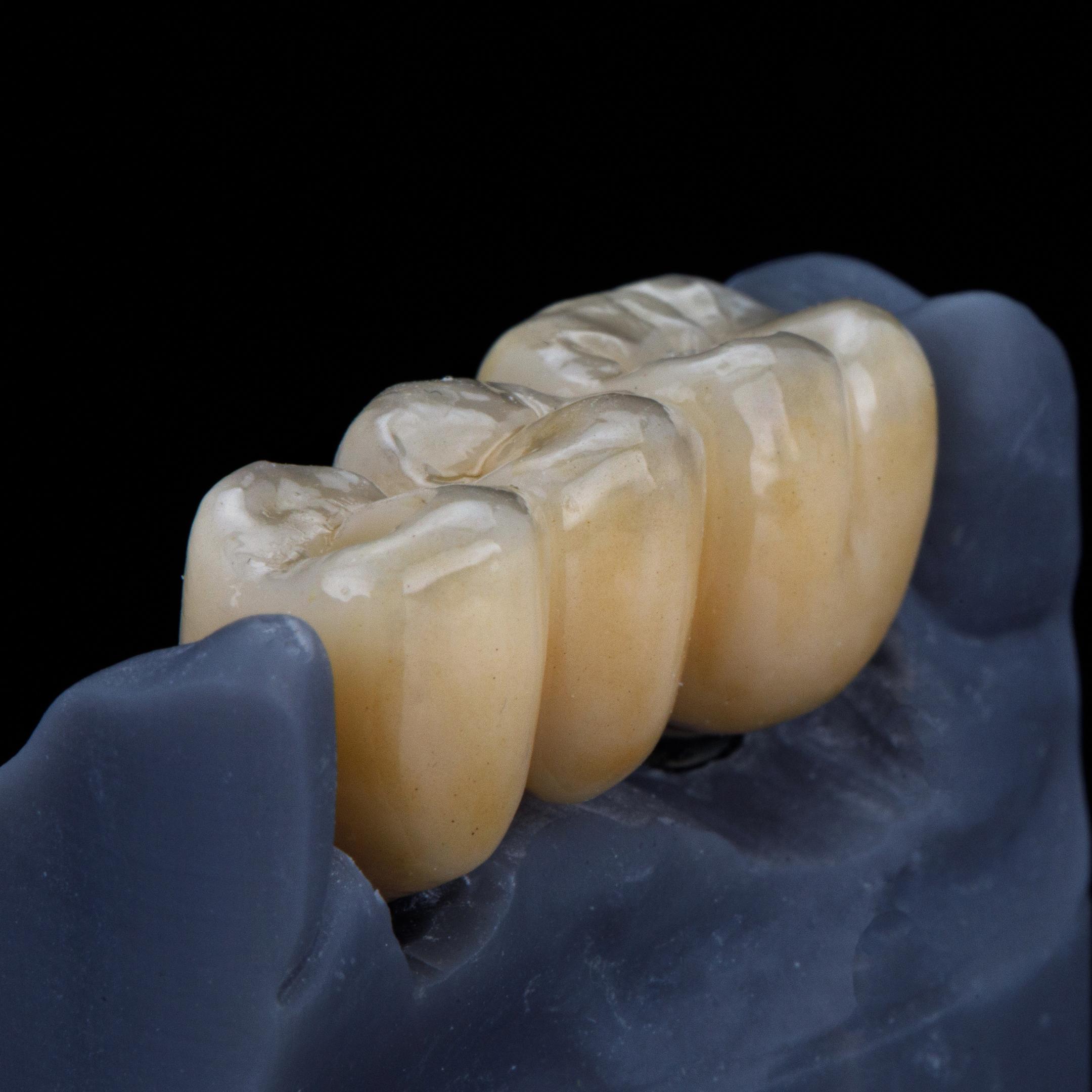Prostheses Types
Fixed Dental Prosthesis
Fixed dental prostheses are those that remain attached to the patient’s mouth; therefore, we cannot remove them, unlike removable prostheses, which can be taken out.
Dental Crowns
In dental prosthetics, the term “dental crown” is used to refer to a custom-made cap for each patient that covers the entire surface of the tooth. This cap perfectly mimics natural teeth in terms of shape and color and fulfills the chewing functions that the patient needs.
The indications for crowns are:
1. To replace lost teeth.
2. To reinforce those that are damaged and at risk of being lost.
*We will mention crowns to replace lost teeth when discussing conventional fixed partial dentures and fixed partial dentures with implants. Now, we will talk about crowns made to reinforce damaged teeth at risk of being lost.
We must emphasize that crowns on natural teeth are rarely used nowadays because, thanks to adhesion and minimally invasive dentistry, we have other alternatives that yield better results without having to trim or remove as much healthy dental structure.
One of the few indications for crowns on natural teeth is to replace dental crowns that have failed for any reason, and another indication is that previously, there was the misconception that a tooth with endodontic treatment should be reinforced with a crown. Today, we know that this belief is completely false.
Nowadays, we work on teeth treated with endodontics under the philosophy of NCNP, which stands for No Crown No Post. This approach is based on minimally invasive dentistry, where we only replace the affected part of the tooth, preserving the maximum amount of healthy structure.
We have different types of materials for making crowns:
- Metal Porcelain Crowns, which have fallen out of use.
- Fully porcelain crowns, which can be made of different materials (feldspathic, lithium disilicate, and zirconia).
*The key point in choosing the material to use is that it helps reproduce the functional and aesthetic characteristics of the natural tooth.
What is CAD/CAM System?
Thanks to design programs, nowadays we can design crowns and restorations through software, which are then manufactured by a milling robot that carves the ceramic.

Conventional Fixed Partial Denture
When we refer to conventional fixed partial dentures, we are talking about what we call bridges over natural teeth, spanning one or more missing teeth.
With this prosthesis, we use the remaining healthy teeth as pillars to support the replacement teeth that we need. The major drawback is that we have to shave down healthy teeth. We can use this type of prosthesis if one or several teeth are missing, as long as we have teeth at the ends to serve as anchors.

Fixed Partial Denture with Implants
Instead of using neighboring teeth that are healthy but require shaving down, we place dental implants that will replace the roots of the lost teeth. Upon these implants, we will attach the crown or crowns of the missing teeth. This type of fixed prosthesis can be used to replace one or several missing teeth.

Fixed Full Denture (with Dental Implants)
We use this prosthesis when the patient has lost all their teeth, and it can only be done with dental implants. The goal of this prosthesis is to replace all the teeth and often the lost gum tissue as well.

Maryland Bridge
The Maryland Bridge is one of the least invasive dental treatments to replace a missing tooth. It’s a fixed adhesive dental prosthesis, meaning it’s bonded with a resin cement to the inner part of the neighboring teeth to the missing tooth. It’s used in areas where a tooth is missing, mainly in the front of the mouth. It’s a very simple treatment, making it an ideal option for quickly restoring smile aesthetics.
These dental prostheses are made of various materials such as porcelain, ceramic, or zirconia.

Maryland Bridge’s Advantages
The great advantage of the Maryland Bridge is that it doesn’t require preparation or shaving down of the supporting teeth, as it adheres to them via two wings on the inner part of the teeth. This characteristic is its main advantage.
Maryland Bridges are one of the best options among dental prostheses due to their practicality. It’s a minimally invasive dental prosthesis with a very simple placement process, making it ideal as a quick and effective solution.
Removable Dental Prosthesis
The removable dental prosthesis is a treatment used to replace missing teeth, whether it’s one, several, or all teeth. As the name suggests, it’s designed and manufactured so that the patient can put it on and take it off as needed, greatly facilitating hygiene.
Removable prostheses transmit forces to the teeth, gums, and bone, so they require an adaptation period, the duration of which varies depending on the individual and the type of prosthesis.
In the end, you probably won’t even be aware of wearing a prosthesis, but it’s necessary to have patience and during this adaptation period, visit the dentist for any necessary adjustments and corrections.



Removable Partial Denture on Teeth
It’s used to replace one or several missing teeth. These prostheses rest on the mucosa and are retained by natural teeth in two ways:
- Through non-rigid devices called retainers or “clasps.”
- Devices on dental crowns to avoid clasps.
Removable Complete Denture
This type of prosthesis rests on the mucosa and is used when the patient has lost all their teeth.
Removable Complete Denture with Implants
Valplast
Valplast is a biocompatible, nylon thermoplastic material that offers greater strength and superior aesthetics compared to conventional acrylic removables.
Among its advantages are:
• Less thickness
• Lightweight
• Flexible
• Acrylic hooks blend in with the gum
• Very aesthetic
The Valplast falls into the category of temporary or transitional removable prostheses , meaning it is used while a permanent option is being placed. This material provides exclusive physical and aesthetic properties, as well as well-proven functionality, making it ideal for partial, unilateral and complete removable dentures, both upper and lower.
Two of the most important points when using this material are functionality, which primarily concerns the dentist, and aesthetics, which is what the patient really demands. Adhesion provides greater comfort and stability in the mouth. Its thinness, two millimeters, competes with the four or five millimeters of conventional acrylic, and is not altered by fluids, being stable over time. In addition, it is hypoallergenic and non-toxic, allowing it to be used in all patients. Added to its unbreakability and flexibility, Valplast meets the demanding requirements of the dentist. Finally, its minimal visibility, lightness and translucency mean that the patient obtains an aesthetic prosthesis, with which he has no qualms about smiling and appearing in public, also giving him great confidence when eating.



